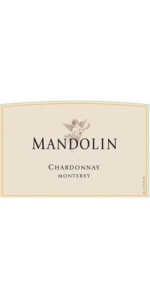Wine from Mandolin

The Mandolin Estate
Mandolin is a collaboration between veteran winemaker Philip Zorn and longtime wine executive Brent Shortridge. Bringing together their previously established relationships with winegrowers in California's Monterey County, Zorn and Shortridge have created wines that stand out for their balance, finesse and distinct varietal character, as well as their sense of place. Mandolin wines are internationally recognized as outstanding values.
A mandolin is a member of the lute family; similar to a guitar, it is plucked or strummed.
The Mandolin Vineyard
The grapes for this Pinot Noir were sourced from vineyards in the Santa Lucia Highlands AVA of Monterey County, where high winds, dry days, and bay fogs create a cool, but very long, growing season. These growing conditions are ideal for cool-climate grapes such as Pinot Noir, and lead to full, forward fruit flavors and ideal acidity. Grapes were harvested at an ideal balance of sugar and acid, and the wine was fermented in small open-top tanks. The wine completed malo-lactic fermentation in French oak barrels, where it aged for 11 months prior to bottling.
With its maritime influence, California's Monterey region has an extended growing season that yields wines with full flavor development and great acid balance.
Mandolin Chardonnay has a lush tropical fruit core, balanced by crisp acidity and nicely integrated oak.
The grapes for this Chardonnay were sourced from vineyards in the Santa Lucia Highlands AVA of Monterey County, where high winds, dry days, and bay fogs create a cool, but very long, growing season. These growing conditions are ideal for cool-climate grapes such as Chardonnay, and lead to full, forward fruit flavors and ideal acidity. Grapes were harvested at an ideal balance of sugar and acid, and the wine was fermented in 1-2 year-old French oak barrels. This wine did not undergo malo-lactic fermentation, thus preserving its bright acidity. Total Acidity: 0.70 pH: 3.45 Residual Sugar: 0.51 g/liter
Mandolin Pinot Noir Monterey is made from 100 percent Pinot Noir.
With its maritime influence, California's Monterey region has an extended growing season that yields wines with full flavor development and great acid balance. Mandolin Pinot Noir has spice, ripe cherry, and savory tones on the nose. It is medium-bodied with polished tannins, showing strawberry and mineral notes.
- back
Selected Options
Wineries
Categories
Pricing
Countries
Regions
Grape Types
Wineries
Organic/Free Shipping
The Special Club concept started in 1971. A dozen wine growers from some old families of Champagne had an idea to familiarize people with the originality of the “Champagne de Vigneron” (Champagne of wine grower), thanks to prestigious vintages.
In the beginning, they created an association called the “Club des Viticulteurs Champenois” and chose a bottle with a special shape, created exclusively for them & used only by then. In 1988, they changed the bottle and the label. In 1999, the Club changed its name to “Club Trésor of Champagne.”
The Club Trésors comprises 28 artisan wine makers, selected from the finest areas of the Champagne region, each one recognized for the quality of their work. The Club Trésors is the only organization in Champagne to select its members according to a set of unrelenting quality standards:
- Each wine maker must make their champagnes entirely in his, or her, own premises and cellars. Furthermore, the champagne must be made exclusively from grapes harvested in his, or her, own vineyards.
- Each wine maker is devoted to his work and passionately protects the quality and the unique character of his own terroir.
- The jury of oenologists and wine professionals who select the champagnes demand irreproachable quality in both the work in the vineyard and the wines.
- Each champagne is subject to two blind tastings (once at the still wine stage before bottling and again after 3 years ageing in bottle) by a panel of passionate and distinguished oenologists and wine makers. 4 years aging minimum is required.
- A Special Club champagne may only be made in outstanding vintage years.
Roland Champion's Special Club selection has rich and structured aromas. Very pleasant and generous roundness, nice length in mouth. Golden color with buttery and fruity aromas. All the expression of a magnificent terroir for your most pleasurable moments.
Long Shadows Cymbal Sauvignon Blanc is made from 100% Sauvignon Blanc.
Tasting notes: Wonderfully vibrant and aromatic, with notes of lemongrass, passion fruit and a hint of honeysuckle. Flavors of mango, fresh herbs and white peach, come together seamlessly across a textured palate and lengthy finish.
Over the years, Gilles and Allen have experimented with small quantities of uniquely styled wines for their personal and family enjoyment. A few of these wines became too good not to share with their “extended family”, including the Cymbal Sauvignon Blanc.
Sauvignon Blanc from three distinct vineyards combined to give this wine its wonderful vibrancy and complex flavor profile. Gamache Vineyard (planted in 1985) is located on a gently sloping hillside in close proximity to the Columbia River. The site benefits from the cooling effect of the river to give the wine fresh acidity. Boushey Vineyard also contributes liveliness and lemongrass character. Bacchus Vineyard Sauvignon Blanc (planted in 1972) is a warmer site, producing a riper style wine that provides a distinct passion fruit character to the
finished blend.






